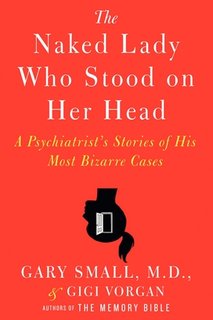
28 Sep 2010 03:00:08
In "The Naked Lady Who Stood on Her Head," Dr. Gary Small delivers on his promise with some fascinating tales (though some cases he writes about, including the naked woman, are less interesting than others).
Apart from describing the patients, Small details his own puzzlements as the cases proceed, giving a look at both sides of the chess match as he and his patients deal with each other. Sometimes he finds out his patients have been deceiving him, and sometimes he discovers the real problem is much different from what it appeared at first.
We read about Small's sudden insights, as when he realizes that a healthy-sounding habit was clogging the mental machinery of an executive. (The exec's reaction to the diagnosis: "That's the craziest thing I've ever heard." But Small was right.)
We meet other patients, like a wealthy recluse in Colorado, a woman with a psychological need to believe she was pregnant, and a plastic surgeon with nightmares about turning into Pinocchio — who wants to marry a woman obsessed with all things Disney.
Along with the stories about his patients, Small mixes in slices of his own everyday life. A bit of this would be fine, but there's just too much of it, and the dialogue often clunks when it aims to be witty. What's more, did Small really have to include wink-wink hints on at least two occasions that he and his wife — who co-authored the book — were about to have sex? What's up with THAT, doc?
It's the patients who make this book, and when the spotlight is on them, it's a good read.
Apart from describing the patients, Small details his own puzzlements as the cases proceed, giving a look at both sides of the chess match as he and his patients deal with each other. Sometimes he finds out his patients have been deceiving him, and sometimes he discovers the real problem is much different from what it appeared at first.
We read about Small's sudden insights, as when he realizes that a healthy-sounding habit was clogging the mental machinery of an executive. (The exec's reaction to the diagnosis: "That's the craziest thing I've ever heard." But Small was right.)
We meet other patients, like a wealthy recluse in Colorado, a woman with a psychological need to believe she was pregnant, and a plastic surgeon with nightmares about turning into Pinocchio — who wants to marry a woman obsessed with all things Disney.
Along with the stories about his patients, Small mixes in slices of his own everyday life. A bit of this would be fine, but there's just too much of it, and the dialogue often clunks when it aims to be witty. What's more, did Small really have to include wink-wink hints on at least two occasions that he and his wife — who co-authored the book — were about to have sex? What's up with THAT, doc?
It's the patients who make this book, and when the spotlight is on them, it's a good read.

